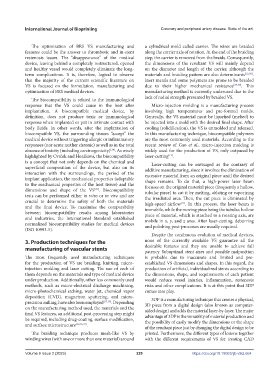Page 237 - IJB-9-2
P. 237
International Journal of Bioprinting Coronary and peripheral artery disease. State of the art.
The optimization of BRS VS manufacturing and a cylindrical mold called carrier. The wires are braided
features could be the answer to thrombotic and in-stent along the carrier axis of rotation. At the end of the braiding
restenosis issues. The “disappearance” of the medical step, the carrier is removed from the braids. Consequently,
device, leaving behind a completely restructured, opened the dimensions of the resultant VS will mainly depend
and healthy vessel would completely eliminate the long- on the diameter and length of the carrier, although the
term complications. It is, therefore, logical to observe materials and braiding pattern are also determinants [12,38] .
that the majority of the current scientific literature on Inert metals and some polymers are prone to be braided
VS is focused on the formulation, manufacturing and due to their higher mechanical resistance [39,40] . This
optimization of BRS medical devices. manufacturing method is currently underused due to the
The biocompatibility is related to the immunological lack of radial strength presented by braided VS.
response that the VS could cause in the host after Micro-injection molding is a manufacturing process
implantation. A biocompatible medical device, by involving high temperatures and pre-formed molds.
definition, does not produce toxic or immunological Generally, the VS material must be liquefied (melted) to
response when implanted or put in intimate contact with be injected into a mold with the desired final shape. After
body fluids. In other words, after the implantation of cooling (solidification), the VS is unmolded and released.
biocompatible VS, the surrounding tissues “accept” the In this manufacturing technique, biocompatible polymers
medical device without triggering allergic or inflammatory are the most commonly used materials. According to the
responses (nor acute neither chronic) as well as in the total recent review of Gao et al., micro-injection molding is
absence of toxicity (including carcinogenicity) . As wisely widely used for the production of VS, only outpaced by
[34]
highlighted by Cvrček and Horáková, the biocompatibility laser-cutting .
[12]
is a concept that not only depends on the chemical and Laser-cutting can be envisaged as the contrary of
superficial composition of the device, but also on its additive manufacturing, since it involves the elimination of
interaction with the surroundings, the period of the excessive material from an original piece until the desired
implant application, the mechanical properties (adaptable shape remains. To do that, a high-power laser beam
to the mechanical properties of the host tissue) and the focuses on the original material piece (frequently a hollow,
dimensions and shape of the VS . Biocompatibility tubular piece) to cut it by melting, ablating or vaporizing
[35]
tests can be performed either in vitro or in vivo and are the irradiated area. Then, the cut piece is eliminated by
crucial to determine the safety of both the materials high-speed airflow . In this process, the laser beam is
[12]
and the final device. To maximize the comparability immobile, while the moving piece being the tubular, hollow
between biocompatibility results among laboratories piece of material, which is attached to a rotating axis, are
and industries, the International Standard established mobile in x, y, and z axes. After laser-cutting, deburring
normalized biocompatibility studies for medical devices and polishing post-processes are usually required.
(ISO 10993-5).
Despite the continuous evolution of medical devices,
3. Production techniques for the none of the currently available VS guarantee all the
manufacturing of vascular stents desirable features and they are unable to achieve full
patency. Suboptimal stent sizes and possible malposition
The most frequently used manufacturing techniques is probable due to inaccurate and limited and pre-
for the production of VS are braiding, knitting, micro- established VS dimensions and shapes. In this regard, the
injection molding and laser cutting. The use of each of production of artificial, individualized stents according to
them depends on the materials and type of medical device the dimensions, shape, and requirements of each patient
under production. Additionally, other less commonly used would reduce vessel injuries, inflammation, restenosis
methods, such as micro-electrical discharge machining, risks and other complications. It is at this point that 3DP
micro-photochemical etching, water jet, chemical vapor comes into play.
deposition (CVD), magnetron sputtering, and micro- 3DP is a manufacturing technique that creates a physical,
precision milling, have also been employed [12,28] . Depending 3D piece from a digital design (also known as computer-
on the manufacturing method used, the materials and the aided design) and adds the material layer-by-layer. The major
final VS features, an additional post-processing step might advantage of 3DP is the versatility of material production and
be required, including drug-coating, surface modification, the possibility of easily modify the dimensions or the shape
and surface microstructure [12,36,37] .
of the resultant piece just by changing the digital design to be
The braiding technique produces mesh-like VS by printed. Furthermore, the different types of lesions together
winding wires (with one or more than one material) around with the different requirements of VS for treating CAD
Volume 9 Issue 2 (2023) 229 https://doi.org/10.18063/ijb.v9i2.664

